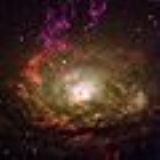
List of spiral galaxies
Encyclopedia
A spiral galaxy
is a type of galaxy
characterized by a central bulge
of old Population II star
s surrounded by a rotating disc of younger Population I stars. A spiral galaxy maintains its spirals arms due to Density wave theory
Spiral galaxy
A spiral galaxy is a certain kind of galaxy originally described by Edwin Hubble in his 1936 work The Realm of the Nebulae and, as such, forms part of the Hubble sequence. Spiral galaxies consist of a flat, rotating disk containing stars, gas and dust, and a central concentration of stars known as...
is a type of galaxy
Galaxy
A galaxy is a massive, gravitationally bound system that consists of stars and stellar remnants, an interstellar medium of gas and dust, and an important but poorly understood component tentatively dubbed dark matter. The word galaxy is derived from the Greek galaxias , literally "milky", a...
characterized by a central bulge
Bulge (astronomy)
In astronomy, a bulge is a tightly packed group of stars within a larger formation. The term almost exclusively refers to the central group of stars found in most spiral galaxies...
of old Population II star
Star
A star is a massive, luminous sphere of plasma held together by gravity. At the end of its lifetime, a star can also contain a proportion of degenerate matter. The nearest star to Earth is the Sun, which is the source of most of the energy on Earth...
s surrounded by a rotating disc of younger Population I stars. A spiral galaxy maintains its spirals arms due to Density wave theory
Density wave theory
Density wave theory or the Lin-Shu density wave theory is a theory proposed by C.C. Lin and Frank Shu in the mid-1960s to explain spiral arm structure of spiral galaxies. Their theory introduces the idea of long-lived quasistatic density waves , which are sections of the galactic disk that have...
Spiral galaxies
| Designation | Picture | Classification | Constellation Constellation In modern astronomy, a constellation is an internationally defined area of the celestial sphere. These areas are grouped around asterisms, patterns formed by prominent stars within apparent proximity to one another on Earth's night sky.... |
Apparent Magnitude Apparent magnitude The apparent magnitude of a celestial body is a measure of its brightness as seen by an observer on Earth, adjusted to the value it would have in the absence of the atmosphere... |
|---|---|---|---|---|
| Comet Galaxy Comet Galaxy The Comet Galaxy is a spiral galaxy located 3.2 billion light-years from Earth, in the galaxy cluster Abell 2667, was found with the Hubble Space Telescope. This galaxy has a little more mass than our Milky Way... |
S | Sculptor Sculptor (constellation) Sculptor is a small and faint constellation in the southern sky. It represents a sculptor. It was introduced by Nicolas Louis de Lacaille in the 18th century. He originally named it Apparatus Sculptoris , but the name was later shortened.-Notable features:No stars brighter than 3rd magnitude are... |
||
| ESO 97-G13, Circinus Galaxy Circinus Galaxy The Circinus Galaxy is a Seyfert Galaxy in the Circinus constellation. It is only 4 degrees below the Galactic plane, and 13 million light-years away. The galaxy is undergoing tumultuous changes, as rings of gas are being ejected from the galaxy. The outermost ring is 700 light-years from the... |
 |
S | Circinus Circinus The constellation Circinus is a small constellation in the southern sky, first defined in the 18th century. Its name is Latin for compass, referring to the drafting tool used for drawing circles; it should not be confused with Pyxis, a constellation that represents a mariner's... |
11 |
| ESO 269-57 ESO 269-57 ESO 269-57 is a barred spiral galaxy approximately 155 million light-years away in the constellation Centaurus. It is a member of a well-known cluster of galaxies seen in this direction... |
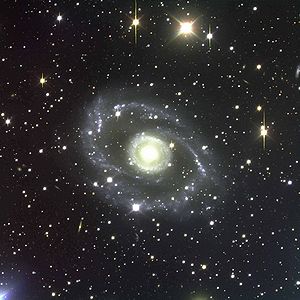 |
SB(r)a | Centaurus Centaurus Centaurus is a bright constellation in the southern sky. One of the largest constellations, Centaurus was included among the 48 constellations listed by the 2nd century astronomer Ptolemy, and it remains one of the 88 modern constellations.-Stars:... |
12.49 |
| ESO 510-G13 ESO 510-G13 ESO 510-G13 is a spiral galaxy approximately 150 million light-years away in the constellation Hydra. The equatorial dust cloud is heavily warped; this may indicate that ESO 510-G13 has interacted with another galaxy... |
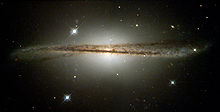 |
Sa: pec sp | Hydra Hydra (constellation) Hydra is the largest of the 88 modern constellations, measuring 1303 square degrees. It has a long history, having been included among the 48 constellations listed by the 2nd century astronomer Ptolemy. It is commonly represented as a water snake... |
13.4 |
| IC 342 IC 342 IC 342 is an intermediate spiral galaxy in the constellation Camelopardalis. The galaxy is located near the galactic equator where dust obscuration makes it a difficult object for both amateur and professional astronomers to observe.IC 342 is one of the brightest two galaxies in the IC 342/Maffei... |
SAB(rs)cd | Camelopardalis Camelopardalis Camelopardalis is a large but faint constellation in the northern sky. The constellation was introduced in 1612 by Petrus Plancius. Some older astronomy books give an alternative spelling of the name, Camelopardus.-Etymology:... |
9.1 | |
| IC 442 IC 442 IC 442 is a spiral galaxy in the constellation Camelopardalis.... |
S | Camelopardalis Camelopardalis Camelopardalis is a large but faint constellation in the northern sky. The constellation was introduced in 1612 by Petrus Plancius. Some older astronomy books give an alternative spelling of the name, Camelopardus.-Etymology:... |
13.8 | |
| IC 1296 IC 1296 IC 1296 is a barred spiral galaxy in the constellation Lyra. It is a low surface brightness galaxy that lies in line of sight 4' to the northwest of the more famous planetary nebula M57 Ring Nebula. IC 1296 is much farther away - an estimated distance of ~221-million lightyears as compared to... |
SBbc | Lyra Lyra Lyra is a small constellation. It is one of the 48 constellations listed by the 2nd century astronomer Ptolemy, and remains one of the 88 modern constellations recognized by the International Astronomical Union. Its principal star, Vega — a corner of the Summer Triangle — is one of the brightest... |
14.8 | |
| ISOHDFS 27 ISOHDFS 27 ISOHDFS 27 is the most massive spiral galaxy known so far. It is approximately 6 billion light years from Earth. It has a mass of 1.04 solar masses , about four times as massive as the Milky Way.... |
S | |||
| IC 2163 NGC 2207 and IC 2163 NGC 2207 and IC 2163 are a pair of colliding spiral galaxies about 80 million light-years away in the constellation Canis Major. Both galaxies were discovered by John Herschel in 1835. So far three supernovae have been observed in NGC 2207... |
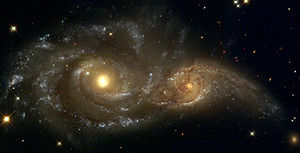 |
SB(rs)c pec | Canis Major Canis Major Canis Major is one of the 88 modern constellations, and was included in the 2nd-century astronomer Ptolemy's 48 constellations. Its name is Latin for 'greater dog', and is commonly represented as one of the dogs following Orion the hunter... |
11.6 |
| IC 4970 NGC 6872 and IC 4970 NGC 6872 and IC 4970 are a set of interacting galaxies over 200 million light-years away in the constellation Pavo.On March 29, 1999, the European Southern Observatory took a look at these galaxies. It shows the spectacular barred spiral galaxy NGC 6872 that is shaped like an "integral sign"... |
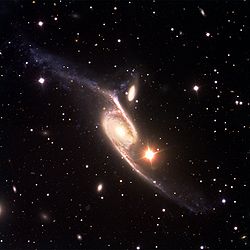 |
SA0- pec | Pavo Pavo (constellation) Pavo is a constellation in the southern sky. Its name is Latin for peacock. It is one of twelve constellations created by Petrus Plancius from the observations of Pieter Dirkszoon Keyser and Frederick de Houtman and it first appeared on a 35-cm diameter celestial globe published in 1597 in... |
12.7 |
| LEDA 100170, Dwingeloo 1 Dwingeloo 1 Dwingeloo 1 is a barred spiral galaxy about 10 million light-years away from the Earth, in the constellation Cassiopeia. It lies in the Zone of Avoidance and is heavily obscured by the Milky Way... |
SB(s)cd | Cassiopeia Cassiopeia (constellation) Cassiopeia is a constellation in the northern sky, named after the vain queen Cassiopeia in Greek mythology, who boasted about her unrivalled beauty. Cassiopea was one of the 48 constellations listed by the 2nd century Greek astronomer Ptolemy, and it remains one of the 88 modern constellations today... |
8.3 | |
| M31, Andromeda Andromeda Galaxy The Andromeda Galaxy is a spiral galaxy approximately 2.5 million light-years from Earth in the constellation Andromeda. It is also known as Messier 31, M31, or NGC 224, and is often referred to as the Great Andromeda Nebula in older texts. Andromeda is the nearest spiral galaxy to the... |
SA(s)b | Andromeda Andromeda (constellation) Andromeda is a constellation in the northern sky. It is named after Andromeda, the princess in the Greek legend of Perseus who was chained to a rock to be eaten by the sea monster Cetus... |
4.36 | |
| M33, Triangulum Galaxy Triangulum Galaxy The Triangulum Galaxy is a spiral galaxy approximately 3 million light years from Earth in the constellation Triangulum. It is catalogued as Messier 33 or NGC 598, and is sometimes informally referred to as the Pinwheel Galaxy, a nickname it shares with Messier 101... |
SA(s)cd | Triangulum | 6.3 | |
| M51a Whirlpool Galaxy The Whirlpool Galaxy is an interacting grand-design spiral galaxy that is estimated to be 23 ± 4 million light-years from the Milky Way Galaxy. in the constellation Canes Venatici... , Whirlpool Galaxy Whirlpool Galaxy The Whirlpool Galaxy is an interacting grand-design spiral galaxy that is estimated to be 23 ± 4 million light-years from the Milky Way Galaxy. in the constellation Canes Venatici... |
SA(s)bc pec | Canes Venatici Canes Venatici Canes Venatici is one of the 88 official modern constellations. It is a small northern constellation that was created by Johannes Hevelius in the 17th century. Its name is Latin for "hunting dogs", and the constellation is often depicted in illustrations as representing the dogs of Boötes the... |
9.0 | |
| M58 Messier 58 Messier 58 is a barred spiral galaxy located within the constellation Virgo, approximately 68 million light-years away from Earth. It was discovered by Charles Messier on April 15, 1779 and is one of four barred spiral galaxies that appear in Messier's catalogue. M58 is one of the brightest... |
SAB(rs)b | Virgo Virgo (constellation) Virgo is one of the constellations of the zodiac. Its name is Latin for virgin, and its symbol is . Lying between Leo to the west and Libra to the east, it is the second largest constellation in the sky... |
10.5 | |
| M61 Messier 61 Messier 61 is a spiral galaxy in the Virgo Cluster. It was discovered by Barnabus Oriani on May 5, 1779.M61 is one of the larger members of the Virgo Cluster.Six supernovae have been observed in this galaxy:... |
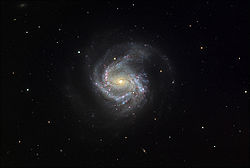 |
SAB(rs)bc | Virgo Virgo (constellation) Virgo is one of the constellations of the zodiac. Its name is Latin for virgin, and its symbol is . Lying between Leo to the west and Libra to the east, it is the second largest constellation in the sky... |
10.2 |
| M63, Sunflower Galaxy Sunflower Galaxy The Sunflower Galaxy is a spiral galaxy in the constellation Canes Venatici consisting of a central disc surrounded by many short spiral arm segments... |
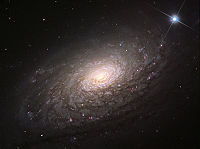 |
SA(rs)bc | Canes Venatici Canes Venatici Canes Venatici is one of the 88 official modern constellations. It is a small northern constellation that was created by Johannes Hevelius in the 17th century. Its name is Latin for "hunting dogs", and the constellation is often depicted in illustrations as representing the dogs of Boötes the... |
9.3 |
| M64, Black Eye Galaxy Black Eye Galaxy The Black Eye Galaxy was discovered by Edward Pigott in March 1779, and independently by Johann Elert Bode in April of the same year, as well as by Charles Messier in 1780... |
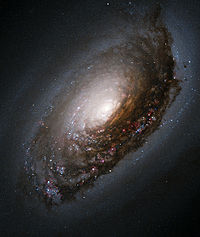 |
(R)SA(rs)ab | Coma Berenices Coma Berenices Coma Berenices is a traditional asterism that has since been defined as one of the 88 modern constellations. It is located near Leo, to which it formerly belonged, and accommodates the North Galactic Pole... |
9.4 |
| M65 Messier 65 Messier 65 is an intermediate spiral galaxy about 35 million light-years away in the constellation Leo. It was discovered by Charles Messier in 1780. M65, M66, and NGC 3628 comprise the famous Leo Triplet, a small group of galaxies.-Discovery:M65 was discovered by Charles Messier and included in... |
SAB(rs)a | Leo Leo (constellation) Leo is one of the constellations of the zodiac. Its name is Latin for lion. Its symbol is . Leo lies between dim Cancer to the west and Virgo to the east.-Stars:... |
10.3 | |
| M66 Messier 66 Messier 66 is an intermediate spiral galaxy about 36 million light-years away in the constellation Leo. It was discovered by Charles Messier in 1780... |
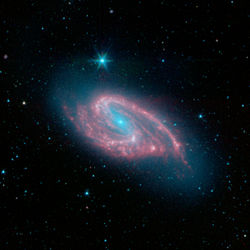 |
SAB(s)b | Leo Leo (constellation) Leo is one of the constellations of the zodiac. Its name is Latin for lion. Its symbol is . Leo lies between dim Cancer to the west and Virgo to the east.-Stars:... |
9.7 |
| M74 Messier 74 Messier 74 is a face-on spiral galaxy in the constellation Pisces. It is at a distance of about 32 million light-years away from Earth. The galaxy contains two clearly defined spiral arms and is therefore used as an archetypal example of a Grand Design Spiral Galaxy... |
SA(s)c | Pisces Pisces (constellation) Pisces is a constellation of the zodiac. Its name is the Latin plural for fish, and its symbol is . It lies between Aquarius to the west and Aries to the east... |
9.95 | |
| M77 Messier 77 Messier 77 is a barred spiral galaxy about 47 million light-years away in the constellation Cetus. Messier 77 is an active galaxy with an Active Galactic Nucleus , which is obscured from view by astronomical dust at visible wavelengths... |
(R)SA(rs)b | Cetus Cetus Cetus is a constellation. Its name refers to Cetus, a sea monster in Greek mythology, although it is often called 'the whale' today. Cetus is located in the region of the sky that contains other water-related constellations such as Aquarius, Pisces, and Eridanus.-Ecliptic:Although Cetus is not... |
9.6 | |
| M81 Messier 81 Messier 81 is a spiral galaxy about 12 million light-years away in the constellation Ursa Major. Due to its proximity to Earth, large size and active galactic nucleus Messier 81 (also known as NGC 3031 or Bode's Galaxy) is a spiral galaxy about 12 million light-years away in the constellation Ursa... |
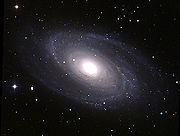 |
SA(s)ab | Ursa Major Ursa Major Ursa Major , also known as the Great Bear, is a constellation visible throughout the year in most of the northern hemisphere. It can best be seen in April... |
7.9 |
| M83 | SAB(s)c | Hydra Hydra (constellation) Hydra is the largest of the 88 modern constellations, measuring 1303 square degrees. It has a long history, having been included among the 48 constellations listed by the 2nd century astronomer Ptolemy. It is commonly represented as a water snake... |
8.2 | |
| M88 Messier 88 Messier 88 is a spiral galaxy about 47 million light-years away in the constellation Coma Berenices. It was discovered by Charles Messier in 1781.-Properties:... |
SA(rs)b | Coma Berenices Coma Berenices Coma Berenices is a traditional asterism that has since been defined as one of the 88 modern constellations. It is located near Leo, to which it formerly belonged, and accommodates the North Galactic Pole... |
10.4 | |
| M90 Messier 90 Messier 90 is a spiral galaxy about 60 million light-years away in the constellation Virgo. It was discovered by Charles Messier in 1781.- Membership of the Virgo Cluster :... |
SAB(rs)ab | Virgo Virgo (constellation) Virgo is one of the constellations of the zodiac. Its name is Latin for virgin, and its symbol is . Lying between Leo to the west and Libra to the east, it is the second largest constellation in the sky... |
10.3 | |
| M91 Messier 91 Messier 91 is a barred spiral galaxy located in the Coma Berenices constellation and is part of the Virgo Cluster of galaxies. M91 is about 63 million light-years away from the earth. It was the last of a group of eight nebulae discovered by Charles Messier in 1781... |
SBb(rs) | Coma Berenices Coma Berenices Coma Berenices is a traditional asterism that has since been defined as one of the 88 modern constellations. It is located near Leo, to which it formerly belonged, and accommodates the North Galactic Pole... |
11.0 | |
| M94 Messier 94 Messier 94 is a spiral galaxy in the constellation Canes Venatici. It was discovered by Pierre Méchain in 1781,... |
 |
SA(r)ab | Canes Venatici Canes Venatici Canes Venatici is one of the 88 official modern constellations. It is a small northern constellation that was created by Johannes Hevelius in the 17th century. Its name is Latin for "hunting dogs", and the constellation is often depicted in illustrations as representing the dogs of Boötes the... |
9.0 |
| M95 Messier 95 Messier 95 is a barred spiral galaxy about 38 million light-years away in the constellation Leo. It was discovered by Pierre Méchain in 1781, and catalogued by Charles Messier four days later.-Nucleus:... |
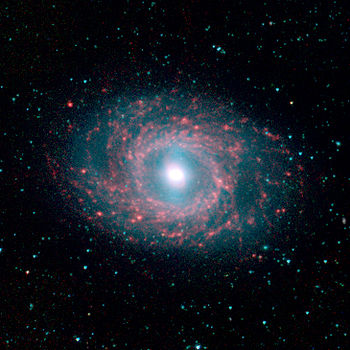 |
SB(r)b | Leo Leo (constellation) Leo is one of the constellations of the zodiac. Its name is Latin for lion. Its symbol is . Leo lies between dim Cancer to the west and Virgo to the east.-Stars:... |
11.4 |
| M96 Messier 96 Messier 96 is an intermediate spiral galaxy about 31 million light-years away in the constellation Leo. It was discovered by Pierre Méchain in 1781.-M96 Group:... |
SAB(rs)ab | Leo Leo (constellation) Leo is one of the constellations of the zodiac. Its name is Latin for lion. Its symbol is . Leo lies between dim Cancer to the west and Virgo to the east.-Stars:... |
10.1 | |
| M98 Messier 98 Messier 98 is an intermediate spiral galaxy about 60 million light-years away in the constellation Coma Berenices. It was discovered by Pierre Méchain on March 15, 1781 along with M99 and M100 and was cataloged as a Messier object on April 13, 1781... |
SAB(s)ab | Coma Berenices Coma Berenices Coma Berenices is a traditional asterism that has since been defined as one of the 88 modern constellations. It is located near Leo, to which it formerly belonged, and accommodates the North Galactic Pole... |
11 | |
| M99 Messier 99 Messier 99 is an unbarred spiral galaxy approximately 50 million light-years away in the constellation Coma Berenices.... , Coma Pinwheel Galaxy |
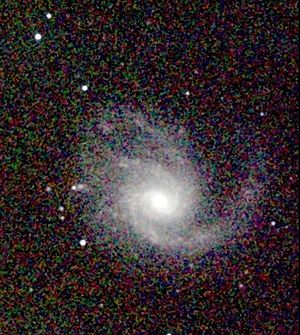 |
SA(s)c | Coma Berenices Coma Berenices Coma Berenices is a traditional asterism that has since been defined as one of the 88 modern constellations. It is located near Leo, to which it formerly belonged, and accommodates the North Galactic Pole... |
10.4 |
| M100 Messier 100 Messier 100 is an example of a grand design spiral galaxy located within the southern part of constellation Coma Berenices. It is one of the brightest galaxies in the Virgo cluster, approximately 55 million light-years distant from Earth and has a diameter of 160,000 light years... |
SAB(s)bc | Coma Berenices Coma Berenices Coma Berenices is a traditional asterism that has since been defined as one of the 88 modern constellations. It is located near Leo, to which it formerly belonged, and accommodates the North Galactic Pole... |
10.1 | |
| M101, Pinwheel Galaxy Pinwheel Galaxy The Pinwheel Galaxy is a face-on spiral galaxy distanced 21 million light-years away in the constellation Ursa Major, first discovered by Pierre Méchain on March 27, 1781, and communicated to Charles Messier who verified its position for inclusion in the Messier Catalogue as one of its final... |
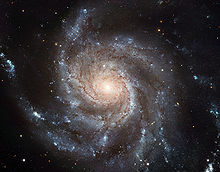 |
SAB(rs)cd | Ursa Major Ursa Major Ursa Major , also known as the Great Bear, is a constellation visible throughout the year in most of the northern hemisphere. It can best be seen in April... |
8.3 |
| M104, Sombrero Galaxy Sombrero Galaxy The Sombrero Galaxy is an unbarred spiral galaxy in the constellation Virgo located 28 million light years from earth. It has a bright nucleus, an unusually large central bulge, and a prominent dust lane in its inclined disk. The dark dust lane and the bulge give this galaxy the appearance of a... |
 |
SA(s)a | Virgo Virgo (constellation) Virgo is one of the constellations of the zodiac. Its name is Latin for virgin, and its symbol is . Lying between Leo to the west and Libra to the east, it is the second largest constellation in the sky... |
9.0 |
| M106 Messier 106 Messier 106 is a spiral galaxy in the constellation Canes Venatici. It was discovered by Pierre Méchain in 1781. M106 is at a distance of about 22 to 25 million light-years away from Earth... |
SAB(s)bc | Canes Venatici Canes Venatici Canes Venatici is one of the 88 official modern constellations. It is a small northern constellation that was created by Johannes Hevelius in the 17th century. Its name is Latin for "hunting dogs", and the constellation is often depicted in illustrations as representing the dogs of Boötes the... |
9.1 | |
| M108 Messier 108 Messier 108 is a barred spiral galaxy in the constellation Ursa Major. It was discovered by Pierre Méchain in 1781 or 1782. From the perspective of the Earth, this galaxy is seen almost edge-on.... |
SB(s)cd | Ursa Major Ursa Major Ursa Major , also known as the Great Bear, is a constellation visible throughout the year in most of the northern hemisphere. It can best be seen in April... |
10.7 | |
| M109 Messier 109 Messier 109 is a barred spiral galaxy approximately away in the constellation Ursa Major. M109 can be seen southeast of the star Phecda .-History:Messier 109 was discovered by Pierre Méchain in 1781... |
SB(rs)bc | Ursa Major Ursa Major Ursa Major , also known as the Great Bear, is a constellation visible throughout the year in most of the northern hemisphere. It can best be seen in April... |
10.6 | |
| Maffei 2 Maffei 2 Maffei 2 is an intermediate spiral galaxy about 10 million light-years away in the constellation Cassiopeia. Maffei 2 and Maffei 1 were both discovered by Paolo Maffei in 1968 from their infrared emission. Maffei 2 lies in the Zone of Avoidance and is about 99.5% obscured by the Milky Way's... |
 |
SAB(rs)bc | Cassiopeia Cassiopeia (constellation) Cassiopeia is a constellation in the northern sky, named after the vain queen Cassiopeia in Greek mythology, who boasted about her unrivalled beauty. Cassiopea was one of the 48 constellations listed by the 2nd century Greek astronomer Ptolemy, and it remains one of the 88 modern constellations today... |
16.0 |
| Milky Way Milky Way The Milky Way is the galaxy that contains the Solar System. This name derives from its appearance as a dim un-resolved "milky" glowing band arching across the night sky... |
 |
SBa | N/A | N/A |
| NGC 1 NGC 1 NGC 1 is a spiral galaxy located 190 million light-years away in the constellation Pegasus. At about 90,000 light-years in diameter, it is just a little smaller than our galaxy, the Milky Way. It is the first object listed in the New General Catalogue... |
SA(s)b | Pegasus Pegasus (constellation) Pegasus is a constellation in the northern sky, named after the winged horse Pegasus in Greek mythology. It was one of the 48 constellations listed by the 2nd century astronomer Ptolemy, and remains one of the 88 modern constellations.-Stars:... |
13.65 | |
| NGC 2 NGC 2 NGC 2 is a spiral galaxy in the constellation Pegasus. It lies slightly to the south of NGC 1. It is a faint spiral galaxy of apparent magnitude 14.2.-External links:* Source:... |
Sab | Pegasus Pegasus (constellation) Pegasus is a constellation in the northern sky, named after the winged horse Pegasus in Greek mythology. It was one of the 48 constellations listed by the 2nd century astronomer Ptolemy, and remains one of the 88 modern constellations.-Stars:... |
+15.0 | |
| NGC 17 NGC 17 NGC 17 is a spiral galaxy in the constellation Cetus.NGC 17 is the result of a merger between two disk galaxies, resulting in a recent starburst in the central regions and continuing starforming activity. The galaxy is still gas-rich, and has a single galactic nucleus. It lies 250 million light... |
.jpg) |
Sc | Cetus Cetus Cetus is a constellation. Its name refers to Cetus, a sea monster in Greek mythology, although it is often called 'the whale' today. Cetus is located in the region of the sky that contains other water-related constellations such as Aquarius, Pisces, and Eridanus.-Ecliptic:Although Cetus is not... |
15.3 |
| NGC 47 NGC 47 NGC 47 is a barred spiral galaxy in the constellation Cetus, discovered in 1886 by Ernst Wilhelm Leberecht Tempel. Its alternate name NGC 58 is due to the observation by Lewis Swift, who was unaware that Tempel had already discovered the object earlier... |
SB(rs)bc | Cetus Cetus Cetus is a constellation. Its name refers to Cetus, a sea monster in Greek mythology, although it is often called 'the whale' today. Cetus is located in the region of the sky that contains other water-related constellations such as Aquarius, Pisces, and Eridanus.-Ecliptic:Although Cetus is not... |
13.5 | |
| NGC 247 NGC 247 NGC 247 is an Intermediate spiral galaxy about 11.1 Mly away in the constellation Cetus. This distance was confirmed in late February 2011. Previous measurements showed that the galaxy was about 12.2 Mly away, but was proved to be wrong... |
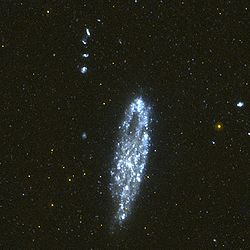 |
SAB(s)d | Cetus Cetus Cetus is a constellation. Its name refers to Cetus, a sea monster in Greek mythology, although it is often called 'the whale' today. Cetus is located in the region of the sky that contains other water-related constellations such as Aquarius, Pisces, and Eridanus.-Ecliptic:Although Cetus is not... |
9.9 |
| NGC 253, Sculptor Galaxy Sculptor Galaxy The Sculptor Galaxy is an intermediate spiral galaxy in the constellation Sculptor... |
 |
SAB(s)c | Sculptor Sculptor (constellation) Sculptor is a small and faint constellation in the southern sky. It represents a sculptor. It was introduced by Nicolas Louis de Lacaille in the 18th century. He originally named it Apparatus Sculptoris , but the name was later shortened.-Notable features:No stars brighter than 3rd magnitude are... |
8.0 |
| NGC 300 NGC 300 NGC 300 is a spiral galaxy in the constellation Sculptor. It is one of the closest galaxies to the Local Group, and probably lies between us and the Sculptor Group. It is the brightest of the five main spirals in the direction of the Sculptor Group... |
 |
SA(s)d | Sculptor Sculptor (constellation) Sculptor is a small and faint constellation in the southern sky. It represents a sculptor. It was introduced by Nicolas Louis de Lacaille in the 18th century. He originally named it Apparatus Sculptoris , but the name was later shortened.-Notable features:No stars brighter than 3rd magnitude are... |
9.0 |
| NGC 514 NGC 514 NGC 514 is an intermediate spiral galaxy approximately 100 million light-years from the Milky Way. It has a H II nucleus.... |
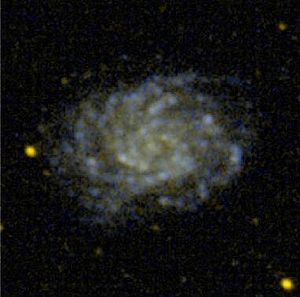 |
SAB(rs)c | Pisces Pisces (constellation) Pisces is a constellation of the zodiac. Its name is the Latin plural for fish, and its symbol is . It lies between Aquarius to the west and Aries to the east... |
12.2 |
| NGC 625 NGC 625 NGC 625 is a barred spiral galaxy about 12.7 Mly away in the constellation Phoenix. NGC 625 is a member of the Sculptor Group.... |
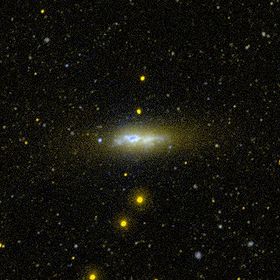 |
SB(s)m | Phoenix Phoenix (constellation) Phoenix is a minor constellation in the southern sky. It is named after the Phoenix, a mythical bird. It is faint: there are only two stars in the whole constellation which are brighter than magnitude 5.0... |
11.7 |
| NGC 772 NGC 772 NGC 772 is an unbarred spiral galaxy approximately 130 million light-years away in the constellation Aries. It is notable for possessing a single elongated outer spiral arm, which has likely arisen due to tidal interactions with nearby galaxies... |
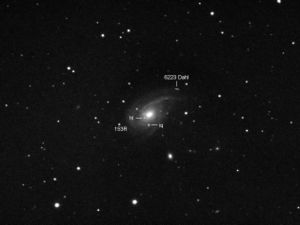 |
SA(s)b | Aries Aries (constellation) Aries is one of the constellations of the zodiac, located between Pisces to the west and Taurus to the east. Its name is Latin for ram, and its symbol is , representing a ram's horns... |
11.1 |
| NGC 891 NGC 891 NGC 891 is an edge-on unbarred spiral galaxy about 30 million light-years away in the constellation Andromeda. It was discovered by William Herschel on October 6 1784. The galaxy is a member of the NGC 1023 group of galaxies in the Local Supercluster... |
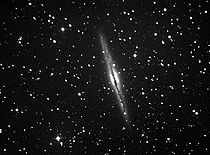 |
SA(s)b | Andromeda Andromeda (constellation) Andromeda is a constellation in the northern sky. It is named after Andromeda, the princess in the Greek legend of Perseus who was chained to a rock to be eaten by the sea monster Cetus... |
10.8 |
| NGC 1032 NGC 1032 NGC 1032 is a spiral galaxy that is about 117 million light-years away in the constellation Cetus.... |
S0/a | Cetus Cetus Cetus is a constellation. Its name refers to Cetus, a sea monster in Greek mythology, although it is often called 'the whale' today. Cetus is located in the region of the sky that contains other water-related constellations such as Aquarius, Pisces, and Eridanus.-Ecliptic:Although Cetus is not... |
12.6 | |
| NGC 1042 NGC 1042 -Nearby galaxies:The galaxy appears near the spiral galaxy NGC 1035 in the sky, and both have similar redshifts. The two objects may therefore be physically associated with each other.... |
SAB(rs)cd | Cetus Cetus Cetus is a constellation. Its name refers to Cetus, a sea monster in Greek mythology, although it is often called 'the whale' today. Cetus is located in the region of the sky that contains other water-related constellations such as Aquarius, Pisces, and Eridanus.-Ecliptic:Although Cetus is not... |
14.0 | |
| NGC 1055 NGC 1055 NGC 1055 is an edge-on spiral galaxy located in the constellation Cetus that has a prominent nuclear bulge crossed by a wide, knotty, dark lane of dust and gas. The spiral arm structure appears to be elevated above the galaxy's plane and obscures the upper half of the bulge... |
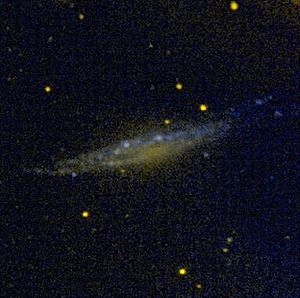 |
SBb:II-III: spindle | Cetus Cetus Cetus is a constellation. Its name refers to Cetus, a sea monster in Greek mythology, although it is often called 'the whale' today. Cetus is located in the region of the sky that contains other water-related constellations such as Aquarius, Pisces, and Eridanus.-Ecliptic:Although Cetus is not... |
11.6 |
| NGC 1087 NGC 1087 NGC 1087 is an intermediate spiral galaxy in Cetus. The central bar/core is very small with many irregular features in the surrounding disk of material. With the many strange features of NGC 1087, its true nature is still uncertain. It has an extremely small nucleus and a very short stellar bar.... |
SAB(rs)c | Cetus Cetus Cetus is a constellation. Its name refers to Cetus, a sea monster in Greek mythology, although it is often called 'the whale' today. Cetus is located in the region of the sky that contains other water-related constellations such as Aquarius, Pisces, and Eridanus.-Ecliptic:Although Cetus is not... |
12.2 | |
| NGC 1090 NGC 1090 Galaxy NGC 1090 is a barred spiral galaxy with a pseudo inner ring. The disc has a very low surface brightness.This galaxy has been the site of two known supernovae .... |
SB(rs)bc | Cetus Cetus Cetus is a constellation. Its name refers to Cetus, a sea monster in Greek mythology, although it is often called 'the whale' today. Cetus is located in the region of the sky that contains other water-related constellations such as Aquarius, Pisces, and Eridanus.-Ecliptic:Although Cetus is not... |
12.5 | |
| NGC 1097 NGC 1097 NGC 1097 is a barred spiral galaxy about 45 million light-years away in the constellation Fornax. As of 2006, three supernovae have been observed in NGC 1097.... |
R'_1:)SB(r'l)bSy1 | Fornax Fornax Fornax is a constellation in the southern sky. Its name is Latin for furnace. It was created in the 18th century and is now one of the 88 modern constellations.-History:Fornax was formed by Nicolas Louis de Lacaille in 1756... |
10.2 | |
| NGC 1232 NGC 1232 NGC 1232 is an intermediate spiral galaxy about 60 million light-years away in the constellation Eridanus.It is dominated by millions of bright stars and dark dust, in spiral arms rotating about the center. Open clusters containing bright blue stars are sprinkled along these spiral arms, with dark... |
 |
SAB(rs)c | Eridanus Eridanus (constellation) Eridanus is a constellation. It is represented as a river; its name is the Ancient Greek name for the Po River. It was one of the 48 constellations listed by the 2nd century astronomer Ptolemy, and it remains one of the 88 modern constellations. It is the sixth largest of the modern... |
10.9 |
| NGC 1300 NGC 1300 NGC 1300 is a barred spiral galaxy about 61 million light-years away in the constellation Eridanus. The galaxy is about 110,000 light-years across; just slightly larger than our own galaxy, the Milky Way. It may be part of the Eridanus Cluster... |
 |
(R')SB(s)bc | Eridanus Eridanus (constellation) Eridanus is a constellation. It is represented as a river; its name is the Ancient Greek name for the Po River. It was one of the 48 constellations listed by the 2nd century astronomer Ptolemy, and it remains one of the 88 modern constellations. It is the sixth largest of the modern... |
11.4 |
| NGC 1365 NGC 1365 NGC 1365, also known as the Great Barred Spiral Galaxy, is a barred spiral galaxy about 56 million light-years away in the constellation Fornax.The core is an oval shape with an apparent size of about 50″ × 40″.... |
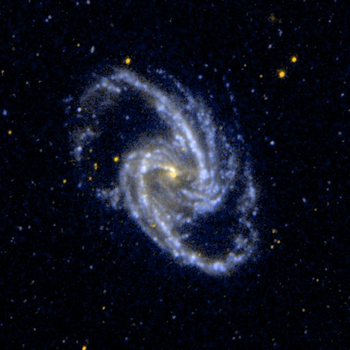 |
(R')SBb(s)b | Fornax Fornax Fornax is a constellation in the southern sky. Its name is Latin for furnace. It was created in the 18th century and is now one of the 88 modern constellations.-History:Fornax was formed by Nicolas Louis de Lacaille in 1756... |
10.3 |
| NGC 1512 NGC 1512 NGC 1512 is a barred spiral galaxy approximately 30 million light-years away from Earth in the constellation Horologium. It is a member of the Dorado Group.-External links:* *... |
SB(r)ab | Horologium Horologium Horologium is a small and faint constellation in the southern sky . Its name is Latin for clock. It was created in the 18th century by Abbé Nicolas Louis de Lacaille, who originally named it Horologium Oscillitorium after the pendulum clock to honour its inventor, Christiaan Huygens... |
11.1 | |
| NGC 1532 | SB(s)b pec | Eridanus Eridanus (constellation) Eridanus is a constellation. It is represented as a river; its name is the Ancient Greek name for the Po River. It was one of the 48 constellations listed by the 2nd century astronomer Ptolemy, and it remains one of the 88 modern constellations. It is the sixth largest of the modern... |
10.7 | |
| NGC 1637 NGC 1637 NGC 1637 is an intermediate spiral galaxy about 25 million light-years away in the constellation Eridanus. A supernova was observed in NGC 1637.... |
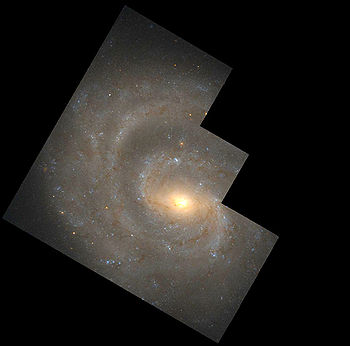 |
SAB(rs)c | Eridanus Eridanus (constellation) Eridanus is a constellation. It is represented as a river; its name is the Ancient Greek name for the Po River. It was one of the 48 constellations listed by the 2nd century astronomer Ptolemy, and it remains one of the 88 modern constellations. It is the sixth largest of the modern... |
11.5 |
| NGC 2207 NGC 2207 and IC 2163 NGC 2207 and IC 2163 are a pair of colliding spiral galaxies about 80 million light-years away in the constellation Canis Major. Both galaxies were discovered by John Herschel in 1835. So far three supernovae have been observed in NGC 2207... |
 |
SAB(rs)bc pec | Canis Major Canis Major Canis Major is one of the 88 modern constellations, and was included in the 2nd-century astronomer Ptolemy's 48 constellations. Its name is Latin for 'greater dog', and is commonly represented as one of the dogs following Orion the hunter... |
12.2 |
| NGC 2403 NGC 2403 NGC 2403 is an intermediate spiral galaxy in the constellation Camelopardalis. NGC 2403 is an outlying member of the M81 Group, and is approximately 8 million light-years distant... |
 |
SAB(s)cd | Camelopardalis Camelopardalis Camelopardalis is a large but faint constellation in the northern sky. The constellation was introduced in 1612 by Petrus Plancius. Some older astronomy books give an alternative spelling of the name, Camelopardus.-Etymology:... |
8.9 |
| NGC 2442 NGC 2442 NGC 2442 / 2443 is an intermediate spiral galaxy about 50 million light-years away in the constellation Volans. It was discovered by Sir John Herschel. Associated with this galaxy is HIPASS J0731-69, a cloud of gas devoid of any stars... |
SAB(s)bc pec | Volans Volans Volans is a constellation in the southern sky. It represents a flying fish; its name is a shortened form of its original name, Piscis Volans... |
11.2 | |
| NGC 2541 NGC 2541 NGC 2541 is an unbarred spiral galaxy located about 40 million light-years away. It is in NGC 2841 group with NGC 2500, NGC 2537, and NGC 2552 galaxies.-External links:*... |
SA(s)cd | Lynx Lynx (constellation) Lynx is a constellation in the northern sky, introduced in the 17th century by Johannes Hevelius. It is named after the lynx, a genus of cat. It is a very faint constellation; its brightest stars form a zigzag line.-History:... |
12.3 | |
| NGC 2683 NGC 2683 NGC 2683 is an unbarred spiral galaxy discovered by William Herschel on February 5, 1788. It was nicknamed the "UFO Galaxy" by the Astronaut Memorial Planetarium and Observatory. It is viewed nearly edge-on from Earth's location in space and is located between 16 to 25 million light-years away. It... |
SA(rs)b | Lynx Lynx (constellation) Lynx is a constellation in the northern sky, introduced in the 17th century by Johannes Hevelius. It is named after the lynx, a genus of cat. It is a very faint constellation; its brightest stars form a zigzag line.-History:... |
10.6 | |
| NGC 2715 NGC 2715 NGC 2715 is a type SABc spiral galaxy and a part of the Camelopardalis.... |
SABc | Camelopardalis Camelopardalis Camelopardalis is a large but faint constellation in the northern sky. The constellation was introduced in 1612 by Petrus Plancius. Some older astronomy books give an alternative spelling of the name, Camelopardus.-Etymology:... |
12 | |
| NGC 2841 NGC 2841 NGC 2841 is an inclined unbarred spiral galaxy in the constellation Ursa Major. Initially thought to be about 30 million light years distant, a 2001 Hubble Space Telescope survey of the galaxy's Cepheid variables determined that it was approximately 14.1 megaparsecs or 46 million light years distant... |
 |
SA(r)b | Ursa Major Ursa Major Ursa Major , also known as the Great Bear, is a constellation visible throughout the year in most of the northern hemisphere. It can best be seen in April... |
10.1 |
| NGC 2903 NGC 2903 NGC 2903 is a barred spiral galaxy about 30 million light-years away in the constellation Leo. It was discovered by William Herschel who cataloged it on November 16, 1784. NGC 2905 is a bright star cloud within this galaxy.- Additional images :... |
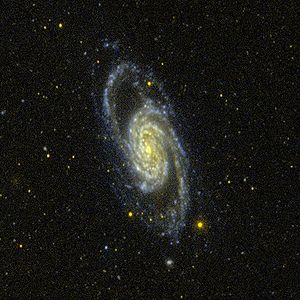 |
SB(s)d | Leo Leo (constellation) Leo is one of the constellations of the zodiac. Its name is Latin for lion. Its symbol is . Leo lies between dim Cancer to the west and Virgo to the east.-Stars:... |
9.7 |
| NGC 2976 NGC 2976 Part of the M81 group, NGC 2976, located 1° 20′ southwest of M81, is an unbarred spiral galaxy. The inner structure contains many dark lanes and stellar condensations in its disk. The galaxy is sometimes classified as Sdp because its spiral arms are difficult to be traced. The bright inner... |
 |
SAc pec | Ursa Major Ursa Major Ursa Major , also known as the Great Bear, is a constellation visible throughout the year in most of the northern hemisphere. It can best be seen in April... |
10.8 |
| NGC 2997 NGC 2997 NGC 2997 is a face-on unbarred spiral galaxy about 40 million light-years away in the constellation Antlia. It is the brightest galaxy of the NGC 2997 group of galaxies.... |
 |
SA(s)c | Antlia Antlia Antlia is a constellation in the southern sky. Its name means "pump" and it specifically represents an air pump. The stars comprising Antlia are faint, and the constellation was not created until the 18th century... |
10.1 |
| NGC 3054 NGC 3054 NGC 3054 is an intermediate spiral galaxy in the constellation Hydra. It was discovered by Christian Heinrich Friedrich Peters in 1859. In January 2006, a supernova was obsered in NGC 3054. It is probably in the same galaxy group as NGC 2935.... |
SAB(r)bc | Hydra Hydra (constellation) Hydra is the largest of the 88 modern constellations, measuring 1303 square degrees. It has a long history, having been included among the 48 constellations listed by the 2nd century astronomer Ptolemy. It is commonly represented as a water snake... |
12.6 | |
| NGC 3079 NGC 3079 NGC 3079 is a barred spiral galaxy about 50 million light-years away, and located in the constellation Ursa Major. A prominent feature of this galaxy is the "bubble" forming in the very center .-Center Bubble:... |
SB(s)c | Ursa Major Ursa Major Ursa Major , also known as the Great Bear, is a constellation visible throughout the year in most of the northern hemisphere. It can best be seen in April... |
11.5 | |
| NGC 3109 NGC 3109 NGC 3109 is a small spiral or irregular galaxy around 4.2 Mly away in the direction of the constellation of Hydra. It is the most prominent member of a Local Group subgroup. NGC 3109 is believed to be tidally interacting with the dwarf elliptical galaxy, Antlia Dwarf... |
 |
SB(s)m | Hydra Hydra (constellation) Hydra is the largest of the 88 modern constellations, measuring 1303 square degrees. It has a long history, having been included among the 48 constellations listed by the 2nd century astronomer Ptolemy. It is commonly represented as a water snake... |
10.4 |
| NGC 3184 NGC 3184 NGC 3184 is a spiral galaxy approximately 40 million light-years away in the constellation Ursa Major. It has two HII regions named NGC 3180 and NGC 3181.... |
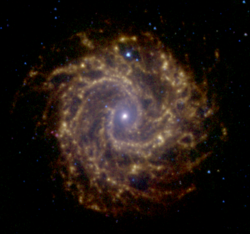 |
SA(s)b | Ursa Major Ursa Major Ursa Major , also known as the Great Bear, is a constellation visible throughout the year in most of the northern hemisphere. It can best be seen in April... |
9.6 |
| NGC 3223 | Antlia | 12 | ||
| NGC 3310 NGC 3310 NGC 3310 is a grand design spiral galaxy in the constellation Ursa Major. It is a starburst galaxy and its likely that NGC 3310 collided with one of its satellite galaxies about 100 million years ago, triggering widespread star formation... |
 |
SAB(r)bc pec | Ursa Major Ursa Major Ursa Major , also known as the Great Bear, is a constellation visible throughout the year in most of the northern hemisphere. It can best be seen in April... |
11.2 |
| NGC 3314 NGC 3314 NGC 3314 is a pair of overlapping spiral galaxies between 117-140 million light-years away in the constellation Hydra. This unique alignment gives astronomers the opportunity to measure the properties of interstellar dust in the face-on foreground galaxy , which appear dark against the background... |
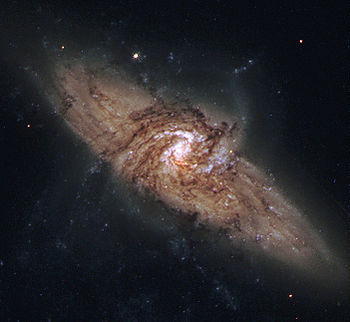 |
SBbc/SAab | Hydra Hydra (constellation) Hydra is the largest of the 88 modern constellations, measuring 1303 square degrees. It has a long history, having been included among the 48 constellations listed by the 2nd century astronomer Ptolemy. It is commonly represented as a water snake... |
12.5 |
| NGC 3370 NGC 3370 NGC 3370 is a spiral galaxy about 98 million light-years away in the constellation Leo. It is comparable to our own Milky Way both in diameter and mass... |
SA(s)c | Leo Leo (constellation) Leo is one of the constellations of the zodiac. Its name is Latin for lion. Its symbol is . Leo lies between dim Cancer to the west and Virgo to the east.-Stars:... |
12.3 | |
| NGC 3486 | Sb | Leo Minor Leo Minor Leo Minor is a small and faint constellation. Its name means "the smaller lion", in contrast to Leo, the larger lion. Its brightest stars form a rough triangle, and it lies between the larger and more recognizable Ursa Major and Leo... |
11.0 | |
| NGC 3521 NGC 3521 NGC 3521 is a type SABbc spiral galaxy 35 million light-years away from Earth.... |
SABbc | Leo Leo (constellation) Leo is one of the constellations of the zodiac. Its name is Latin for lion. Its symbol is . Leo lies between dim Cancer to the west and Virgo to the east.-Stars:... |
10 | |
| NGC 3596 NGC 3596 NGC 3596 is an intermediate spiral galaxy in the constellation Leo. It was discovered by Friedrich Wilhelm Herschel 1784. It is located below the star Theta Leonis .-External links:*... |
SAB(rs)c | Leo Leo (constellation) Leo is one of the constellations of the zodiac. Its name is Latin for lion. Its symbol is . Leo lies between dim Cancer to the west and Virgo to the east.-Stars:... |
12.0 | |
| NGC 3628 NGC 3628 NGC 3628, also known as Sarah's Galaxy, is an unbarred spiral galaxy about 35 million light-years away in the constellation Leo. It was discovered by William Herschel in 1784. It has an approximately 300,000 light-years long tidal tail. NGC 3628 along with M65 and M66 form the famous Leo... |
 |
SAb pec | Leo Leo (constellation) Leo is one of the constellations of the zodiac. Its name is Latin for lion. Its symbol is . Leo lies between dim Cancer to the west and Virgo to the east.-Stars:... |
14.0 |
| NGC 3877 NGC 3877 NGC 3877 is a type Sc spiral galaxy that was discovered by William Herschel on February 5, 1788. It is located below the magnitude 3.7 star Chi Ursae Majoris in Ursa Major.-Supernova:... |
Sc | Ursa Major Ursa Major Ursa Major , also known as the Great Bear, is a constellation visible throughout the year in most of the northern hemisphere. It can best be seen in April... |
12.1 | |
| NGC 3949 NGC 3949 NGC 3949 is an unbarred spiral galaxy in the constellation Ursa Major. It is believed to be approximately 50 million light-years away from the earth.-Supernova:The type II supernova SN 2000db is the only supernova that has been observed within NGC 3949.... |
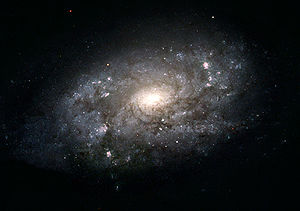 |
SA(s)bc | Ursa Major Ursa Major Ursa Major , also known as the Great Bear, is a constellation visible throughout the year in most of the northern hemisphere. It can best be seen in April... |
11.5 |
| NGC 3953 NGC 3953 NGC 3953 is a barred spiral galaxy located in the constellation Ursa Major.-Supernovae:Two supernovae have been identified within NGC 3953: the type Ia supernova SN 2001dp and SN 2006bp.-Environment:... |
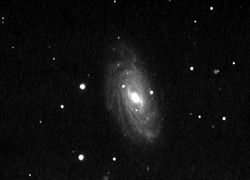 |
SB(r)bc | Ursa Major Ursa Major Ursa Major , also known as the Great Bear, is a constellation visible throughout the year in most of the northern hemisphere. It can best be seen in April... |
10.8 |
| NGC 3982 NGC 3982 NGC 3982 is an intermediate spiral galaxy approximately 68 million light-years away in the constellation Ursa Major. It is also known as UGC 6918. It was discovered by William Herschel on April 14, 1789 and misclassified as planetary nebula. NGC 3982 is a part of the M109 Group.At an apparent... |
 |
SAB(r)b | Ursa Major Ursa Major Ursa Major , also known as the Great Bear, is a constellation visible throughout the year in most of the northern hemisphere. It can best be seen in April... |
12.0 |
| NGC 4013 NGC 4013 NGC 4013 is an edge-on barred spiral galaxy about 55 million light-years away in the constellation Ursa Major. The disk of NGC 4013 shows a distinct "peanut"-shaped bulge in long exposure photographs that N-body computer simulations suggest is consistent with a stellar bar seen perpendicular to... |
SAb | Ursa Major Ursa Major Ursa Major , also known as the Great Bear, is a constellation visible throughout the year in most of the northern hemisphere. It can best be seen in April... |
19.2 | |
| NGC 4027 NGC 4027 NGC 4027 is a barred spiral galaxy approximately 83 million light-years away in the constellation Corvus. It is also a peculiar galaxy because one of its spiral arms goes out more than the other... |
SB(s)dm | Corvus Corvus (constellation) Corvus is a small constellation in the southern sky. Its name is Latin for raven or crow. It includes only 11 stars visible to the naked eye... |
11.7 | |
| NGC 4088 NGC 4088 NGC 4088 is an intermediate spiral galaxy in the constellation Ursa Major. The galaxy forms a physical pair with NGC 4085, which is located 11′ away.-Disk Structure:... |
SAB(rs)bc | Ursa Major Ursa Major Ursa Major , also known as the Great Bear, is a constellation visible throughout the year in most of the northern hemisphere. It can best be seen in April... |
11.2 | |
| NGC 4216 NGC 4216 NGC 4216 is a metal-rich intermediate spiral galaxy located not far from the center of the Virgo Cluster of galaxies, roughly 40 million light-years away.... |
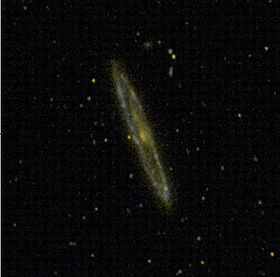 |
SAB(s)b | Virgo Virgo (constellation) Virgo is one of the constellations of the zodiac. Its name is Latin for virgin, and its symbol is . Lying between Leo to the west and Libra to the east, it is the second largest constellation in the sky... |
11.0 |
| NGC 4314 NGC 4314 NGC 4314 is a barred spiral galaxy approximately 40 million light-years away in the constellation Coma Berenices. Perhaps the most prominent and unusual feature is its "nuclear starbust ring" of bright young stars. These rings are thought to be due in part to Lindblad resonance. It is thought... |
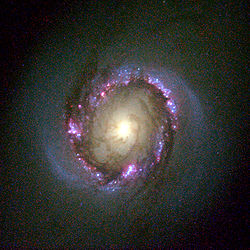 |
SB | Coma Berenices Coma Berenices Coma Berenices is a traditional asterism that has since been defined as one of the 88 modern constellations. It is located near Leo, to which it formerly belonged, and accommodates the North Galactic Pole... |
|
| NGC 4395 NGC 4395 NGC 4395 is a low surface brightness spiral galaxy with a halo that is about 8′ in diameter. It has several wide areas of greater brightness running northwest to southeast. The one furthest southeast is the brightest... |
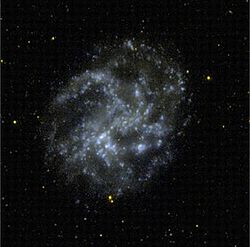 |
SA(s)m | Canes Venatici Canes Venatici Canes Venatici is one of the 88 official modern constellations. It is a small northern constellation that was created by Johannes Hevelius in the 17th century. Its name is Latin for "hunting dogs", and the constellation is often depicted in illustrations as representing the dogs of Boötes the... |
10.6 |
| NGC 4414 NGC 4414 NGC 4414 is an unbarred spiral galaxy about 62 million light-years away in the constellation Coma Berenices. It is a flocculent galaxy, with short segments of spiral structure but without the dramatic well-defined spiral arms of a grand design spiral... |
.jpg) |
SA(rs)c | Coma Berenices Coma Berenices Coma Berenices is a traditional asterism that has since been defined as one of the 88 modern constellations. It is located near Leo, to which it formerly belonged, and accommodates the North Galactic Pole... |
11.0 |
| NGC 4565 NGC 4565 NGC 4565 is an edge-on spiral galaxy about 30 to 50 million light-years away in the constellation Coma Berenices.... |
 |
SA(s)b | Coma Berenices Coma Berenices Coma Berenices is a traditional asterism that has since been defined as one of the 88 modern constellations. It is located near Leo, to which it formerly belonged, and accommodates the North Galactic Pole... |
10.42 |
| NGC 4618 NGC 4618 NGC 4618 is a distorted dwarf galaxy in the constellation Canes Venatici. The galaxy is formally classified as a Sm galaxy, which means that its structure vaguely resembles the structure of spiral galaxies... |
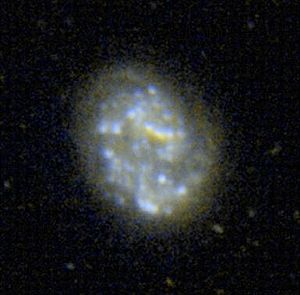 |
SB(rs)m | Canes Venatici Canes Venatici Canes Venatici is one of the 88 official modern constellations. It is a small northern constellation that was created by Johannes Hevelius in the 17th century. Its name is Latin for "hunting dogs", and the constellation is often depicted in illustrations as representing the dogs of Boötes the... |
11.2 |
| NGC 4625 NGC 4625 NGC 4625 is a distorted dwarf galaxy in the constellation Canes Venatici. The galaxy is formally classified as a Sm galaxy, which means that its structure vaguely resembles the structure of spiral galaxies... |
SAB(rs)m pec | Canes Venatici Canes Venatici Canes Venatici is one of the 88 official modern constellations. It is a small northern constellation that was created by Johannes Hevelius in the 17th century. Its name is Latin for "hunting dogs", and the constellation is often depicted in illustrations as representing the dogs of Boötes the... |
13.2 | |
| NGC 4631 NGC 4631 NGC 4631 is an edge-on spiral galaxy in the constellation Canes Venatici. This galaxy's slightly distorted wedge shape gives it the appearance of a herring or a whale, whence its nickname... |
SB(s)d | Canes Venatici Canes Venatici Canes Venatici is one of the 88 official modern constellations. It is a small northern constellation that was created by Johannes Hevelius in the 17th century. Its name is Latin for "hunting dogs", and the constellation is often depicted in illustrations as representing the dogs of Boötes the... |
9.8 | |
| NGC 4725 NGC 4725 NGC 4725 is an intermediate barred spiral galaxy about 40 million light-years away in the constellation Coma Berenices.-External links:* * * *... |
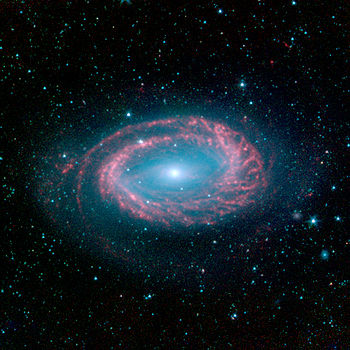 |
SAB(r)ab pec | Coma Berenices Coma Berenices Coma Berenices is a traditional asterism that has since been defined as one of the 88 modern constellations. It is located near Leo, to which it formerly belonged, and accommodates the North Galactic Pole... |
10.1 |
| NGC 4911 NGC 4911 NGC 4911 is a spiral galaxy located deep within the Coma Cluster of galaxies, which lies 320 million light years away in the northern constellation Coma Berenices. The galaxy contains rich lanes of dust and gas near its centre. The existence of clouds of Hydrogen within the galaxy indicates ongoing... |
Unknown | Coma Berenices Coma Berenices Coma Berenices is a traditional asterism that has since been defined as one of the 88 modern constellations. It is located near Leo, to which it formerly belonged, and accommodates the North Galactic Pole... |
Unknown | |
| NGC 4945 NGC 4945 NGC 4945 is a spiral galaxy in the constellation Centaurus. It is thought to be quite similar to the Milky Way Galaxy, but X-ray observations show that NGC 4945 has an unusual, energetic, Seyfert 2 nucleus that might house a large black hole... |
 |
SB(s)cd | Centaurus Centaurus Centaurus is a bright constellation in the southern sky. One of the largest constellations, Centaurus was included among the 48 constellations listed by the 2nd century astronomer Ptolemy, and it remains one of the 88 modern constellations.-Stars:... |
9.3 |
| NGC 5005 NGC 5005 NGC 5005 is an inclined spiral galaxy in the constellation Canes Venatici. The galaxy has a relatively bright nucleus and a bright disk that contains multiple dust lanes... |
 |
SAB(rs)bc | Canes Venatici Canes Venatici Canes Venatici is one of the 88 official modern constellations. It is a small northern constellation that was created by Johannes Hevelius in the 17th century. Its name is Latin for "hunting dogs", and the constellation is often depicted in illustrations as representing the dogs of Boötes the... |
10.6 |
| NGC 5033 NGC 5033 NGC 5033 is an inclined spiral galaxy located in the constellation Canes Venatici. Distance estimates vary from between 38 to 60 million light years from the Milky Way Galaxy. The galaxy has a very bright nucleus and a relatively faint disk. Significant warping is visible in the southern half of... |
SA(s)c | Canes Venatici Canes Venatici Canes Venatici is one of the 88 official modern constellations. It is a small northern constellation that was created by Johannes Hevelius in the 17th century. Its name is Latin for "hunting dogs", and the constellation is often depicted in illustrations as representing the dogs of Boötes the... |
10.8 | |
| NGC 5068 NGC 5068 NGC 5068 is a face-on barred spiral galaxy in the Virgo constellation. NGC 5068 is located approximately 22 million light-years away and has a diameter that exceeds 45 kly.... |
SB(s)d | Virgo Virgo (constellation) Virgo is one of the constellations of the zodiac. Its name is Latin for virgin, and its symbol is . Lying between Leo to the west and Libra to the east, it is the second largest constellation in the sky... |
10.5 | |
| NGC 5078 NGC 5078 NGC 5078 is a spiral galaxy in the Hydra constellation. It is similar in structure to NGC 5746. NGC 5078 is at an estimated 94 million light-years away from Earth.... |
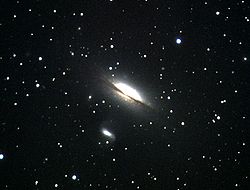 |
SA(s)a | Hydra Hydra (constellation) Hydra is the largest of the 88 modern constellations, measuring 1303 square degrees. It has a long history, having been included among the 48 constellations listed by the 2nd century astronomer Ptolemy. It is commonly represented as a water snake... |
11.8 |
| NGC 5091 | Sb pec sp | Centaurus Centaurus Centaurus is a bright constellation in the southern sky. One of the largest constellations, Centaurus was included among the 48 constellations listed by the 2nd century astronomer Ptolemy, and it remains one of the 88 modern constellations.-Stars:... |
13.9 | |
| NGC 5164 NGC 5164 NGC 5164 is a galaxy in the constellation Ursa Major. It was discovered by John Frederick William Herschel in 1789.... |
SBb | Ursa Major Ursa Major Ursa Major , also known as the Great Bear, is a constellation visible throughout the year in most of the northern hemisphere. It can best be seen in April... |
14.1 | |
| NGC 5257 NGC 5257 NGC 5257 is a spiral galaxy located in the constellation Virgo. The galaxy is notably interacting with the spiral galaxy NGC 5258. The two galaxies are listed together as Arp 240 in the Atlas of Peculiar Galaxies. Both galaxies are distorted by the gravitational interaction, and both are... |
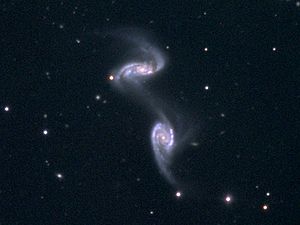 |
SAB(s)b pec | Virgo Virgo (constellation) Virgo is one of the constellations of the zodiac. Its name is Latin for virgin, and its symbol is . Lying between Leo to the west and Libra to the east, it is the second largest constellation in the sky... |
12.9 |
| NGC 5258 NGC 5258 NGC 5258 is a spiral galaxy located in the constellation Virgo. The galaxy is notably interacting with the spiral galaxy NGC 5257. The two galaxies are listed together as Arp 240 in the Atlas of Peculiar Galaxies. Both galaxies are distorted by the gravitational interaction, and both are... |
 |
SA(s)b pec | Virgo Virgo (constellation) Virgo is one of the constellations of the zodiac. Its name is Latin for virgin, and its symbol is . Lying between Leo to the west and Libra to the east, it is the second largest constellation in the sky... |
12.9 |
| NGC 5474 NGC 5474 NGC 5474 is a peculiar dwarf galaxy in the constellation Ursa Major. It is one of several companion galaxies of the Pinwheel Galaxy , a grand-design spiral galaxy.... |
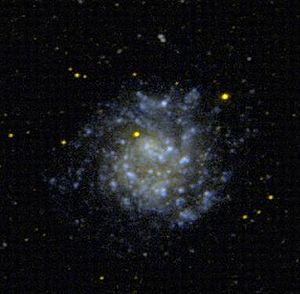 |
SA(s)cd pec | Ursa Major Ursa Major Ursa Major , also known as the Great Bear, is a constellation visible throughout the year in most of the northern hemisphere. It can best be seen in April... |
11.3 |
| NGC 5624 | S | Virgo Virgo (constellation) Virgo is one of the constellations of the zodiac. Its name is Latin for virgin, and its symbol is . Lying between Leo to the west and Libra to the east, it is the second largest constellation in the sky... |
14.6 | |
| NGC 5713 NGC 5713 NGC 5713 is a peculiar, asymmetric galaxy in the constellation Virgo. Although classified as a spiral galaxy by most galaxy catalogs, NGC 5713 galaxy is very different from most normal spiral galaxies. While most spiral galaxies either have either two well-defined spiral arms or a filamentary... |
 |
SAB(rs)bc pec | Virgo Virgo (constellation) Virgo is one of the constellations of the zodiac. Its name is Latin for virgin, and its symbol is . Lying between Leo to the west and Libra to the east, it is the second largest constellation in the sky... |
12.1 |
| NGC 5921 NGC 5921 NGC 5921 is a barred spiral galaxy in the constellation Serpens Caput. One supernova was observed in NGC 5921.... |
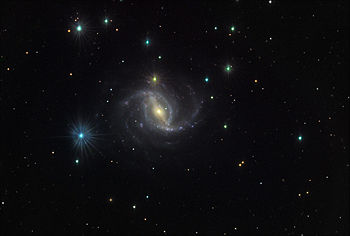 |
SB(r)bc | Serpens Caput | 11.5 |
| NGC 6744 NGC 6744 NGC 6744 is an intermediate spiral galaxy about 30 million light-years away in the constellation Pavo. It is considered one of the most Milky Way-like spiral galaxies in our immediate vicinity, with flocculent arms and an elongated core... |
 |
SAB(r)bc | Pavo Pavo (constellation) Pavo is a constellation in the southern sky. Its name is Latin for peacock. It is one of twelve constellations created by Petrus Plancius from the observations of Pieter Dirkszoon Keyser and Frederick de Houtman and it first appeared on a 35-cm diameter celestial globe published in 1597 in... |
9.14 |
| NGC 6745 NGC 6745 NGC 6745 is an irregular galaxy about 206 million light-years away in the constellation Lyra. It is actually a triplet of galaxies in the process of colliding.... |
S | Lyra Lyra Lyra is a small constellation. It is one of the 48 constellations listed by the 2nd century astronomer Ptolemy, and remains one of the 88 modern constellations recognized by the International Astronomical Union. Its principal star, Vega — a corner of the Summer Triangle — is one of the brightest... |
13.3 | |
| NGC 6872 NGC 6872 and IC 4970 NGC 6872 and IC 4970 are a set of interacting galaxies over 200 million light-years away in the constellation Pavo.On March 29, 1999, the European Southern Observatory took a look at these galaxies. It shows the spectacular barred spiral galaxy NGC 6872 that is shaped like an "integral sign"... |
 |
SAB(rs)c | Pavo Pavo (constellation) Pavo is a constellation in the southern sky. Its name is Latin for peacock. It is one of twelve constellations created by Petrus Plancius from the observations of Pieter Dirkszoon Keyser and Frederick de Houtman and it first appeared on a 35-cm diameter celestial globe published in 1597 in... |
12.7 |
| NGC 6946 NGC 6946 NGC 6946, , is an intermediate spiral galaxy about 22 million light-years away, on the border between the constellations Cepheus and Cygnus. It was discovered by William Herschel on September 9, 1798... |
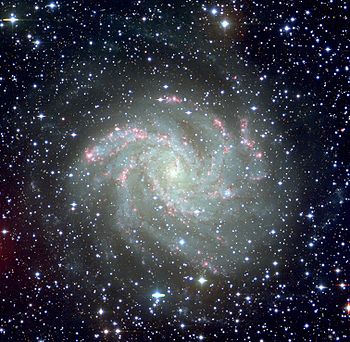 |
SAB(rs)cd | Cepheus Cepheus (constellation) Cepheus is a constellation in the northern sky. It is named after Cepheus, King of Aethiopia in Greek mythology. It was one of the 48 constellations listed by the 2nd century astronomer Ptolemy, and remains one of the 88 modern constellations.-Stars:... |
9.6 |
| NGC 7217 NGC 7217 NGC 7217 is an unbarred spiral galaxy in the constellation Pegasus.-External links:* *... |
 |
(R)SA(r)ab | Pegasus Pegasus (constellation) Pegasus is a constellation in the northern sky, named after the winged horse Pegasus in Greek mythology. It was one of the 48 constellations listed by the 2nd century astronomer Ptolemy, and remains one of the 88 modern constellations.-Stars:... |
11.0 |
| NGC 7318 NGC 7318 NGC 7318 are a set of galaxies about 300 million light-years away in the Constellation Pegasus... |
SB(s)bc pec | Pegasus Pegasus (constellation) Pegasus is a constellation in the northern sky, named after the winged horse Pegasus in Greek mythology. It was one of the 48 constellations listed by the 2nd century astronomer Ptolemy, and remains one of the 88 modern constellations.-Stars:... |
14.4 / 13.9 | |
| NGC 7331 NGC 7331 NGC 7331 is a spiral galaxy about away in the constellation Pegasus. It was discovered by William Herschel in 1784... |
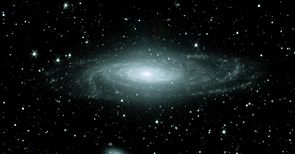 |
SA(s)b | Pegasus Pegasus (constellation) Pegasus is a constellation in the northern sky, named after the winged horse Pegasus in Greek mythology. It was one of the 48 constellations listed by the 2nd century astronomer Ptolemy, and remains one of the 88 modern constellations.-Stars:... |
10.4 |
| NGC 7479 NGC 7479 NGC 7479 is a barred spiral galaxy about 105 million light-years away in the constellation Pegasus. It was discovered by William Herschel in 1784. Supernovae SN 1990U and SN2009jf occurred in NGC 7479. NGC 7479 is also recognized as a Seyfert galaxy undergoing starburst activity in the nucleus... |
 |
SB(s)c | Pegasus Pegasus (constellation) Pegasus is a constellation in the northern sky, named after the winged horse Pegasus in Greek mythology. It was one of the 48 constellations listed by the 2nd century astronomer Ptolemy, and remains one of the 88 modern constellations.-Stars:... |
11.6 |
| NGC 7742 NGC 7742 NGC 7742 is a face-on unbarred spiral galaxy in the constellation Pegasus.The galaxy is unusual in that it contains a ring but no bar. Typically, bars are needed to produce a ring structure. The bars' gravitational forces move gas to the ends of the bars, where it forms into the rings seen in... |
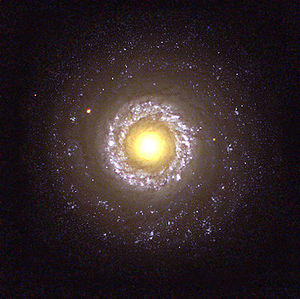 |
SA(r)b | Pegasus Pegasus (constellation) Pegasus is a constellation in the northern sky, named after the winged horse Pegasus in Greek mythology. It was one of the 48 constellations listed by the 2nd century astronomer Ptolemy, and remains one of the 88 modern constellations.-Stars:... |
12.4 |
| NGC 7752 | SAB(rs)bc | Pegasus Pegasus (constellation) Pegasus is a constellation in the northern sky, named after the winged horse Pegasus in Greek mythology. It was one of the 48 constellations listed by the 2nd century astronomer Ptolemy, and remains one of the 88 modern constellations.-Stars:... |
12.8 | |
| NGC 7793 NGC 7793 NGC 7793 is a spiral galaxy about 12.7 million light-years away in the constellation Sculptor. It was discovered in 1826 by James Dunlop.-Galaxy group information:... |
 |
SA(s)d | Sculptor Sculptor (constellation) Sculptor is a small and faint constellation in the southern sky. It represents a sculptor. It was introduced by Nicolas Louis de Lacaille in the 18th century. He originally named it Apparatus Sculptoris , but the name was later shortened.-Notable features:No stars brighter than 3rd magnitude are... |
10.0 |
| NGC 7814 NGC 7814 NGC 7814 is a spiral galaxy about 40 million light-years away in the constellation Pegasus. The galaxy is seen edge-on from Earth. It is sometimes referred to as "the little sombrero", a miniature version of Messier 104... |
 |
SA(S)ab | Pegasus Pegasus (constellation) Pegasus is a constellation in the northern sky, named after the winged horse Pegasus in Greek mythology. It was one of the 48 constellations listed by the 2nd century astronomer Ptolemy, and remains one of the 88 modern constellations.-Stars:... |
11.6 |
| UGC 10214, Tadpole Galaxy Tadpole Galaxy The Tadpole Galaxy is a disrupted barred spiral galaxy located 400 million light years from Earth toward the northern constellation Draco. Its most dramatic features are a trail of stars about 280 thousand light-years long and massive, bright blue star clusters.It is hypothesized that a more... |
 |
SB(s)c pec | Draco Draco (constellation) Draco is a constellation in the far northern sky. Its name is Latin for dragon. Draco is circumpolar for many observers in the northern hemisphere... |
14.4 |

